More on AMD’s XConnect Tech: Thunderbolt 3 for External Radeons
by Ryan Smith on March 10, 2016 9:00 AM EST- Posted in
- GPUs
- AMD
- Intel
- Radeon
- Thunderbolt
- Thunderbolt 3
- eGFX

Last night AMD issued a driver update that brought support for a new technology, XConnect. In a nutshell, XConnect is AMD’s trade name for running external video cards via Thunderbolt 3, a long awaited development that Thunderbolt owner Intel is finally getting behind and allowing. AMD’s driver release notes offered a handful of details, and now the official embargo for the tech is lifting, so we can fill in some of the blanks.
As our more observant readers may recall, when Intel unveiled Thunderbolt 3 back in June, they announced that they would finally be approving external video cards via Thunderbolt, and that they would be partnering with AMD to develop the initial implementation. More recently, at CES 2016 Razer unveiled the Razer Blade Stealth ultrabook, which was being immediately promoted as supporting external video cards, and was being shown off with its accompanying full power Core external video card chassis. Add the two up, and you can guess where this is going.
Today then is the formal launch of AMD’s Thunderbolt 3 video card efforts, which they are branding XConnect. The first drivers for XConnect were released last night, and now AMD is qualifying the Blade Stealth as the first laptop ready for XConnect. That said, it should be noted that while the Blade Stealth has been shipping for some time, Razer’s accompanying Core chassis has yet to ship, so anyone looking to try out XConnect will need to wait to get their hands on a Core.
Along with today’s formal unveiling of the technology, AMD is also laying out the technical requirements for supporting XConnect. Not just any laptop/desktop with Thunderbolt 3 can support an external GPU, as there are specific hardware and software requirements, which is why the Blade Stealth is the first qualified laptop. In particular, laptops need to support what is being called the Thunderbolt 3 external graphics standard, or eGFX for short. The eGFX standard in turn requires that vendors implement the necessary extensions for external graphics into their BIOS, including functionality necessary to support plug ‘n play operation. Also required is v.16 (or later) of the Thunderbolt firmware, Windows 10, and an active (not passive) Thunderbolt cable for bandwidth reasons.
With all of the necessary parts in play, from a technical perspective what we’re looking at is a somewhat more complex AMD Enduro switchable graphics setup, except with an external GPU. XConnect allows for an external video card to feed either a laptop’s internal display via the normal switchable graphics protocols, or an external monitor hooked up to the external video card. I dare say that much of this is mundane in 2016 as switchable graphics have been with us for some number of years now. What is novel here, as Intel told us as far back as June, is that what really changed their tune was that there is finally a sensible GPU hotplugging solution in place, allowing video cards to be added and removed without rebooting. This makes it much easier to use an eGFX solution – hence AMD’s focus on plug ‘n play functionality – and it means the operating system won’t crash and burn if an external video card is removed. Though from AMD’s whitepaper it’s clear that applications using the external GPU will likely crash, which is why external video cards still should be ejected for best results.
On the software side then AMD has gone ahead and implemented just this. The XConnect functionality in the latest Radeon drivers includes a system tray icon that that tells the user what applications are running on an external GPU, and can force close them if necessary to allow the GPU to be ejected/removed.
On the hardware side of matters, AMD is treating this as a high-end solution, and given the costs involved in Thunderbolt 3 I expect this will be the case universally. The company has qualified most of their high end graphics cards, including the R9 280, R9 290 series (sans 295X2), the R9 300 series, R9 Nano, and R9 Fury, while Fury X is excluded since its radiator won’t work with the Razer Core. Also supported are the mobile derivatives of these GPUs – for use in lower-power “graphics dock” devices – and future Polaris dGPUs will be supported as well. Overall from the GPU perspective Thunderbolt is just a higher latency PCIe 3.0 x4 connection, so it affords a lot of compatibility.
| XConnect GPU Compatibility List | ||
| Radeon R9 Fury | ||
| Radeon R9 Nano | ||
| Radeon R9 300 Series | ||
| Radeon R9 290 & 290X | ||
| Radeon R9 280 | ||
| Mobile dGPUs Based on the Above | ||
| Planned: Polaris dGPUs | ||
Meanwhile from a performance perspective AMD isn’t publishing specific numbers on how an external video card performs relative to an internal one, but PCIe 3.0 x4 testing is easy enough to do. With only one-quarter the bandwidth of a full PCIe 3.0 x16 slot Thunderbolt 3 will be constraining at times, but various benchmarks have put the average performance hit for a high-end card at under 10%. That of course will vary from game to game, as games that push a lot of data to the GPU or games that frequently interact with the GPU (e.g. retrieving physics simulation results) will be more greatly impacted by the reduced bandwidth and higher latency than simpler, more straightforward games.
From a broader perspective, the launch of Razer’s Blade Stealth laptop and Core chassis are part of what AMD hopes will be a much larger ecosystem for eGFX-capable laptops and enclosures. While each end needs to be certified, the fact that the transport layer is standardized Thunderbolt 3 means that any chassis should work with any laptop, and future solutions need not be a matching setup ala the Blade Stealth + Core. To that end Thunderbolt eGFX is not the first external graphics solution, but as a standard it has the potential to be more widespread than previous proprietary solutions such as MSI’s Shadow expansion dock or AMD’s own previous XGP initiative, not to mention it’s not tied to any one GPU vendor.
The catch, I suspect, will be getting laptop vendors to include Thunderbolt 3 support, as historically Thunderbolt has seen little traction outside of Apple laptops. The switch from the mini-Displayport connector to the USB Type-C connector is likely to help some with that, but a big consideration will be the space and power requirements of Intel’s Alpine Ridge controller, along with the costs of buying and integrating it.
As for the eGFX chassis, the Razer Core is a solid example of what to expect with high-end designs, which is a Thunderbolt dock on steroids. Along with providing enough power and space for a double-wide 375W video card, it also contains a Gigabit Ethernet port hanging off of the Thunderbolt controller’s PCIe lanes, USB 3.0 ports that are (presumably) coming off of the Alpine Ridge controller itself, and the ability to charge the Blade Stealth laptop. Back at IDF Intel was also pitching the idea for a smaller “graphics dock” concept, which would have a lower-power mobile-class dGPU integrated into a docking device that provided similar I/O functionality, to allow for a cheaper all-in-one device that provided a more modest boost to graphics performance.
Overall, gaming has been one of the few bright spots in an otherwise sluggish PC industry, and that goes for both gaming desktops and gaming laptops. For AMD and Intel, the launch of Thunderbolt eGFX/XConnect in turn allows them to further expand the gaming laptop market, moving beyond desktop replacement class laptops and more limited 15” laptops by offering desktop-class GPU performance to any laptop that incorporates a Thunderbolt 3 port and the necessary BIOS support. At the same time Ultrabooks themselves have been a steady and well received market, though making poor gaming devices due to a lack of space for a dGPU – never mind something that offers desktop-like performance. So after earlier efforts to pair them up with external graphics with any luck this will be the start of a viable gaming Ultrabook market as well.



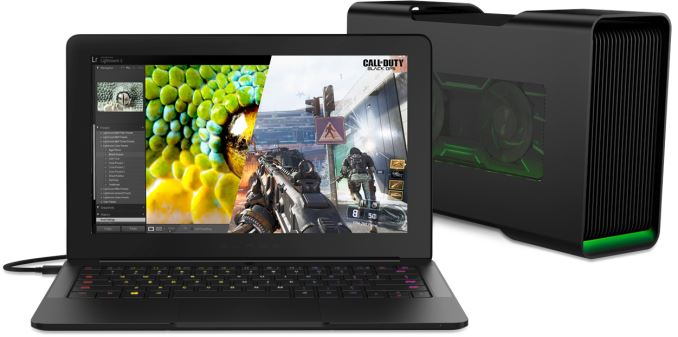
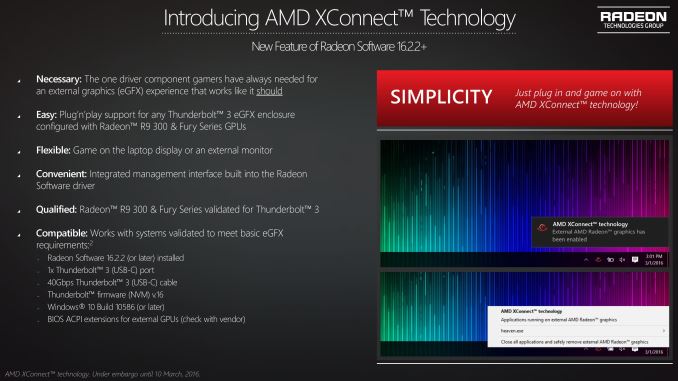
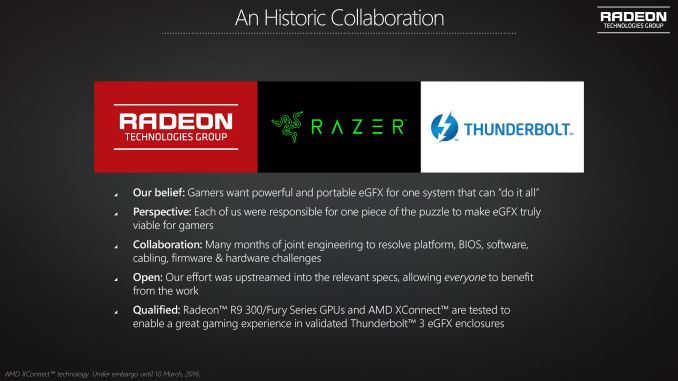
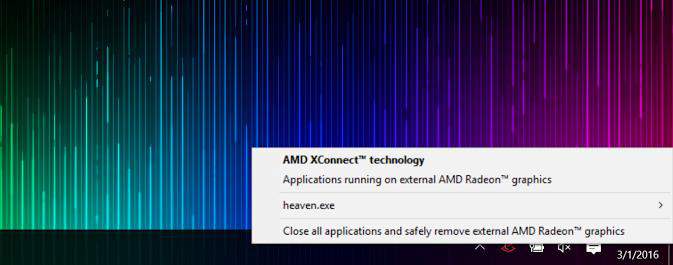

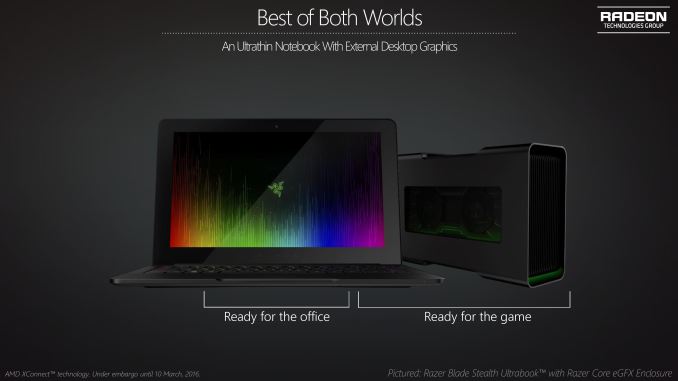














64 Comments
View All Comments
Seikent - Thursday, March 10, 2016 - link
In a desktop, internal switchable graphics (like in notebooks) would make much more sense (why would I want an extra box). I guess that the problem is that desktops are customizable and for Enduro or Optimus to work, they need to exist at a motherboard level (uneducated guess).Murloc - Thursday, March 10, 2016 - link
casual gamers who find themselves stuck with a brand-name desktop PC that has an unbalance towards the GPU (average situation, even for gaming-oriented PCs), will never be let to have support for this by the builders exactly because it stops them from buying a new PC entirely.And desktop gaming PCs have huge margins unlike the cheap office ones (which can have enough CPU power though).
The power consumption argument is moot imho because an external solution costs more money, probably more than the expense for the energy you'd spare, if it's an average graphics card.
DanNeely - Thursday, March 10, 2016 - link
There's no need of an enclosure for that; and it'd just add considerable expense for no real gain. An internal card and switchable graphics would achieve all the power savings; and 2 boxes are more clutter on the desk than just one.Oxford Guy - Friday, March 11, 2016 - link
Not when people demand thin laptops.WithoutWeakness - Thursday, March 10, 2016 - link
I'm not sure where you live but power in the US is pretty cheap. You would need to have significant power savings using your iGPU over your dedicated external GPU in order to actually save any money given the $200+ upfront cost of buying an external Thunderbolt graphics card dock. Even the highest-end enthusiast GPUs sip power at idle or while performing low-level GPU accelerated tasks like video playback. There likely wouldn't be enough of a power savings gap to make it make sense.Not that I'm saying it's pointless and they should never do it but I'd like to see it polished on laptops before putting any significant development effort into any changes they would need to make to support external graphics on desktop machines.
MadAd - Friday, March 11, 2016 - link
Yes finally some traction in the external graphics area. I thought it was only me with a vision of a small ITX type desktop unit with the keyboard and mouse and a bit of storage, an external graphics unit in a thunderbolt box for some hours of gaming and the main storage in an NAS router for all the network and data saving needs.At that point the traditional ATX/uATX format doesnt need to exist any more and we can better use our energy, not just in only firing up graphics when we need gaming, but also savings in non gaming idle modes while afk, plus less heat (in areas where thats a problem).
ET - Thursday, March 10, 2016 - link
I just happened to read the GeForce driver 364.51 release notes and it says: "Added external graphics UI (Windows 10)". So I'm guessing NVIDIA cards will work out of the box with this.Anyway, any hope that this Intel-AMD collaboration will also result in Thunderbolt being available on AMD motherboards?
Murloc - Thursday, March 10, 2016 - link
if they come out with cheap docks and get all ultrabooks to support it this could sell some.A dock is useful on its own but not enough to warrant buying one for most people, if there's a dGPU in it that allows you to play MOBAs and simple FPS games on a road warrior kind of notebook (i.e. light 13'') then that's attractive and can help justify the cost.
I mean, ethernet cable and USB port galore to leave cheap external storage, keyboard, mouse, lan and monitor connected is pretty good.
DanNeely - Thursday, March 10, 2016 - link
"The catch, I suspect, will be getting laptop vendors to include Thunderbolt 3 support, as historically Thunderbolt has seen little traction outside of Apple laptops. The switch from the mini-Displayport connector to the USB Type-C connector is likely to help some with that, but a big consideration will be the space and power requirements of Intel’s Alpine Ridge controller, along with the costs of buying and integrating it."In the short/medium term Alpine Ridge also being one of the very few USB3.1 controllers on the market, when there's no chipset support for the newer protocol version, should help this by reducing the BOM cost.
Ryan Smith - Thursday, March 10, 2016 - link
Laptop makers have so far not been tripping over themselves to add USB 3.1. Space and power are at a premium, so they like to avoid adding additional controllers. Though I agree that Alpine Ridge has a solid place even just as a USB 3.1 controller, I wouldn't consider it a given that it can do any more to convince laptop vendors to include it.